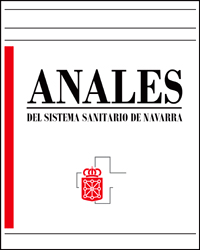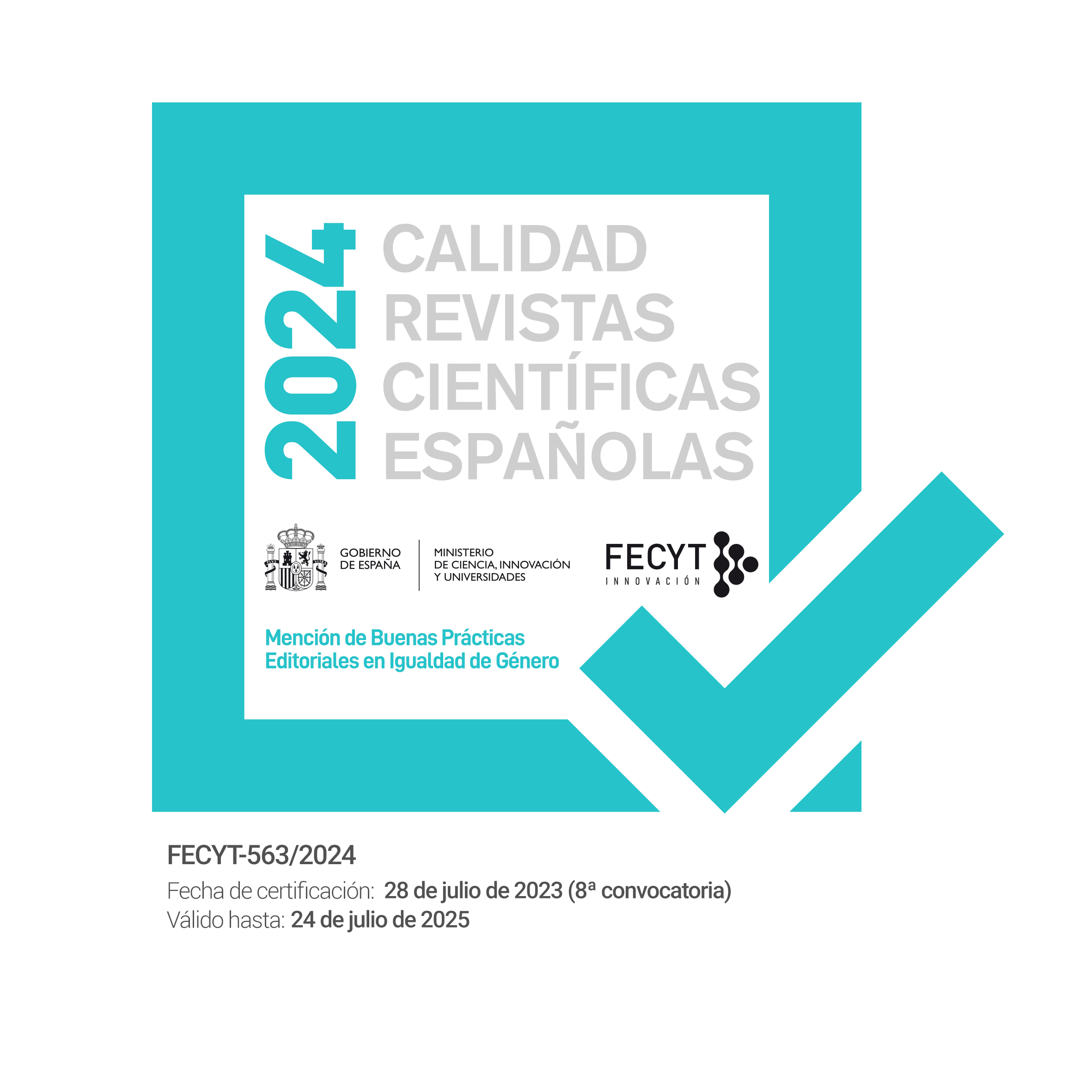Biomarcadores de estrés oxidativo e inflamación en lesión renal aguda postcontraste yodado
DOI:
https://doi.org/10.23938/ASSN.1081Palabras clave:
Lesión renal aguda, Biomarcadores, Contraste yodado, Tomografía computarizada, IohexolResumen
Fundamento. La lesión renal aguda postcontraste yodado (LRAPCY) es una causa frecuente de insuficiencia renal, especialmente en pacientes con factores de riesgo. Este estudio analiza diferentes biomarcadores renales en pacientes sometidos a tomografía computarizada con contraste yodado para identificar los mecanismos moleculares y celulares implicados en la patogénesis de la LRAPCY.
Metodología. Estudio prospectivo de pacientes de alto riesgo renal que recibieron contraste yodado (iohexol) para tomografía computarizada. Se analizaron biomarcadores funcionales (creatinina y cistatina C), de inflamación y estrés oxidativo (lipocalina asociada a gelatinasa de neutrófilos [NGAL], interleucina-8 [IL-8], superóxido dismutasa [SOD], F2-isoprostanos y cardiotrofina-1) y de ciclo celular (Nephrocheck®), precontraste y 4, 12, 24 y 48 horas postcontraste, en relación con la LRAPCY.
Resultados. Se observó LRAPCY en el 30,6% de los 62 pacientes incluidos y en el 57,1% de los pacientes con diabetes y disfunción renal. Los factores asociados con LRAPCY fueron: mayor edad media (74,4 vs 64,9 años), existencia de disfunción renal previa (60 vs 16,7%), y mayor volumen medio ajustado de iohexol (42,9 vs 32,1%). Los pacientes con y sin LRAPCY no difirieron respecto a los biomarcadores no-funcionales. Se observó una disminución de la actividad antioxidante de la SOD a las 4 horas y un aumento de IL-8 a las 12 horas post-administración del contraste yodado.
Conclusiones. La administración de iohexol en tomografía computarizada en pacientes con alto riesgo de enfermedad renal resulta en un elevado porcentaje de LRAPCY, atribuible a daño por isquemia/reperfusión y/o toxicidad directa del contraste yodado.
Descargas
Citas
CHAUDHARI H, MAHENDRAKAR S, BASKIN SE, REDDI AS. Contrast-induced acute kidney injury: evidence in support of its existence and a review of its pathogenesis and management. Int J Nephrol Renovasc Dis 2022;15:253-266. https://doi.org/10.2147/IJNRD.S371700
STANSKI NL, RODRIGUES CE, STRADER M, MURRAY PT, ENDRE ZH, BAGSHAW SM. Precision management of acute kidney injury in the intensive care unit: current state of the art. Intensive Care Med 2023; 49(9): 1049-1061. https://doi.org/10.1007/s00134-023-07171-z
CHENG W, ZHAO F, TANG CY, LI XW, LUO M, DUAN SB. Comparison of iohexol and iodixanol induced nephrotoxicity, mitochondrial damage and mitophagy in a new contrast-induced acute kidney injury rat model. Arch Toxicol 2018; 92: 2245-2257. https://doi.org/10.1007/s00204-018-2225-9
VLACHOPANOS G, SCHIZAS D, HASEMAKI N, GEORGALIS A. Pathophysiology of contrast-induced acute kidney injury (CIAKI). Curr Pharm Des 2019; 25(44): 4642-4647. https://doi.org/10.2174/1381612825666191210152944
CHO E, KO GJ. the pathophysiology and the management of radiocontrast-induced nephropathy. Diagnostics (Basel) 2022; 12(1): 180. https://doi.org/10.3390/diagnostics12010180
D'AMORE C, NUZZO S, BRIGUORI C. Biomarkers of contrast-induced nephropathy: Which ones are clinically important? Interv Cardiol Clin 2020; 9: 335-344. https://doi.org/10.1016/j.iccl.2020.02.004
SCHREZENMEIER EV, BARASCH J, BUDDE K, WESTHOFF T, SCHMIDT-OTT KM. Biomarkers in acute kidney injury - pathophysiological basis and clinical performance. Acta Physiol (Oxf) 2017; 219: 554-572. https://doi.org/10.1111/apha.12764
BIRKELO BC, PANNU N, SIEW ED. Overview of diagnostic criteria and epidemiology of acute kidney injury and acute kidney disease in the critically ill patient. Clin J Am Soc Nephrol 2022; 17:717-735. https://doi.org/10.2215/CJN.14181021
AOUN J, NICOLAS D, BROWN JR, JABER BL. Maximum allowable contrast dose and prevention of acute kidney injury following cardiovascular procedures. Curr Opin Nephrol Hypertens 2018; 27: 121-129. https://doi.org/10.1097/MNH.0000000000000389
FERNANDEZ-RUIZ V, KAWA M, BERASAIN C, IÑIGUEZ M, SCHMITZ V, MARTINEZ-ANSÓ E et al. Treatment of murine fulminant hepatitis with genetically engineered endothelial progenitor cells. J Hepatol 2011; 55: 828-837. https://doi.org/10.1016/j.jhep.2011.01.036
Kidney Disease: Improving Global Outcomes (KDIGO) Acute Kidney Injury work group. KDIGO clinical practice guideline for acute kidney injury. Kidney Inter Suppl 2012; 2 (Suppl 1): 1–138. https://doi.org/10.1038/kisup.2012.2
MARTIN-MORENO PL, VARO N, MARTÍNEZ-ANSÓ E, MARTIN-CALVO N, SAYÓN-OREA C, BILBAO JI, GARCIA-FERNANDEZ N. Comparison of intravenous and oral hydration in the prevention of contrast-induced acute kidney injury in low-risk patients: A randomized trial. Nephron 2015; 131(1): 51-58. https://doi.org/10.1159/000438907
MCDONALD JS, MCDONALD RJ. Risk of acute kidney injury following IV iodinated contrast media exposure: 2023 update, from the AJR special series on contrast media. AJR Am J Roentgenol 2024. https://doi.org/10.2214/AJR.23.30037
SŮVA M, KALA P, POLOCZEK M, KAŇOVSKÝ J, ŠTÍPAL R, RADVAN M et al. Contrast-induced acute kidney injury and its contemporary prevention. Front Cardiovasc Med 2022; 9: 1073072. https://doi.org/10.3389/fcvm.2022.1073072
WEISBORD SD, GALLAGHER M, JNEID H, GARCIA S, CASS A, THWIN SS et al. PRESERVE trial group. outcomes after angiography with sodium bicarbonate and acetylcysteine. N Engl J Med 2018; 378(7): 603-614. https://doi.org/10.1056/NEJMoa1710933
LIANGOS O, KOLYADA A, TIGHIOUART H, PERIANAYAGAM MC, WALD R, JABER BL. Interleukin-8 and acute kidney injury following cardiopulmonary bypass: a prospective cohort study. Nephron Clin Pract 2009 ;113(3): c148-c154. https://doi.org/10.1159/000232595
MARAKALA V. Neutrophil gelatinase-associated lipocalin (NGAL) in kidney injury - A systematic review. Clin Chim Acta 2022; 536: 135-141. https://doi.org/10.1016/j.cca.2022.08.029
FILIOPOULOS V, BIBLAKI D, VLASSOPOULOS D. Neutrophil gelatinase-associated lipocalin (NGAL): a promising biomarker of contrast-induced nephropathy after computed tomography. Ren Fail 2014; 36(6): 979-986. https://doi.org/10.3109/0886022X.2014.900429
MAGNO AL, HERAT LY, CARNAGARIN R, SCHLAICH MP, MATTHEWS VB. CURRENT knowledge of IL-6 cytokine family members in acute and chronic kidney disease. Biomedicines 2019; 7(1): 19. https://doi.org/10.3390/biomedicines7010019
QUIROS Y, SÁNCHEZ-GONZÁLEZ PD, LÓPEZ-HERNÁNDEZ FJ, MORALES AI, LÓPEZ-NOVOA JM. Cardiotrophin-1 administration prevents the renal toxicity of iodinated contrast media in rats. Toxicol Sci 2013; 132(2): 493-501. https://doi.org/10.1093/toxsci/kft007
NALESSO F, CATTARIN L, GOBBI L, FRAGASSO A, GARZOTTO F, CALÒ LA. Evaluating nephrocheck® as a predictive tool for acute kidney injury. Int J Nephrol Renovasc Dis 2020; 13: 85-96. https://doi.org/10.2147/IJNRD.S198222
ROUVE E, LAKHAL K, SALMON GANDONNIÈRE C, JOUAN Y, BODET-CONTENTIN L, EHRMANN S. Lack of impact of iodinated contrast media on kidney cell-cycle arrest biomarkers in critically ill patients. BMC Nephrol 2018; 19(1): 308. https://doi.org/10.1186/s12882-018-1091-2
PICKKERS P, DARMON M, HOSTE E, JOANNIDIS M, LEGRAND M, OSTERMANN M et al. Acute kidney injury in the critically ill: An updated review on pathophysiology and management. Intensive Care Med 2021; 47(8): 835-850. https://doi.org/10.1007/s00134-021-06454-7
MCCULLOUGH PA. Renal safety of iodixanol. Expert Rev Cardiovasc Ther 2006; 4: 655-661. https://doi.org/10.1586/14779072.4.5.655
Publicado
Cómo citar
Número
Sección
Licencia

Esta obra está bajo una licencia internacional Creative Commons Atribución-CompartirIgual 4.0.
La revista Anales del Sistema Sanitario de Navarra es publicada por el Departamento de Salud del Gobierno de Navarra (España), quien conserva los derechos patrimoniales (copyright ) sobre el artículo publicado y favorece y permite la difusión del mismo bajo licencia Creative Commons Reconocimiento-CompartirIgual 4.0 Internacional (CC BY-SA 4.0). Esta licencia permite copiar, usar, difundir, transmitir y exponer públicamente el artículo, siempre que siempre que se cite la autoría y la publicación inicial en Anales del Sistema Sanitario de Navarra, y se distinga la existencia de esta licencia de uso.








